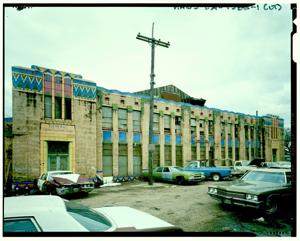
It started with a fire, and a spectacular one at that, spraying a shower of otherworldly sparks and embers into the New Orleans night over the old Independent Laundries building in the Treme-Lafitte neighborhood shortly after 10 p.m. on Feb. 21, 1929.
By the time firefighters arrived at the St. Philip Street structure, the wind-fueled blaze was already out of control. Inside, drums of gasoline began exploding, further stymieing their efforts. That was followed by the explosion of a 12-foot boiler so violent it reportedly sent sparks flying as far as two blocks away.
Then nearby homes started catching fire.
“The entire block was a mass of hoses, running firemen and excited, half-clad people,” read an article in the next day’s Times-Picayune.
When the sun came up, the laundry building was a total loss, as was a duplex on one side of it and, on the other side, the home of the laundry’s president, Robert Chapoit.
A quick reaction
Chapoit didn’t wait long to rebuild. A month after the fire, the laundry was operating out of a facility on Johnson Street near Gravier – but he had bigger plans.
The result was the magnificent General Laundry Cleaners and Dyers building – the name by which his business was going by then – at 2526 St. Peter St., between North Rocheblave and North Dorgenois. The dazzling two-story steel-framed building, covered in stucco and featuring vividly colored terra cotta elements with a unique undulating roofline, has since been called one of the finest examples of Art Deco architecture in the city.
That hasn’t spared it from years of neglect, in addition to repeated brushes with the wrecking ball.
Last month, however, the General Laundry building received a new measure of protection that just might help save it.
The unusual look
Designed by the Shreveport firm of Jones, Roessel, Olschner and Wiener, the façade of the nearly block-long building is adorned with red, green and cornflower blue geometrical motifs – common in Art Deco designs – but with the addition of Aztec-Mayan-inspired ornamentation.
That includes terra cotta depictions of lush tropical vegetation, including a peppering of blue and yellow flowers, as well as a row of 10 pilasters topped with emerald capitals evoking native headdresses. Five larger pilasters on the façade are capped with similarly colored tiles incorporating a sunrise motif surrounded by greenery.
On either end of the building is a pavilion with an entrance – one marked “Employees” and the other marked “Office” – topped with heavily stylized parapets.
It’s unclear what prompted the artistic decisions, but what is clear is that Chapoit couldn’t wait to show off his business’ dazzling new home, which cost a reported quarter of a million dollars (or about $4.4 million today).
A big grand opening
On May 30, 1930, he threw open the doors of the facility and invited the public to marvel at what he was selling as the city’s most modern laundry. Some 5,000 people showed up, according to a Times-Picayune write-up. An orchestra played. Refreshments were served. Speeches were made.
In the years that followed, Chapoit – who, as a prominent political operative in the city’s 7th Ward, apparently knew how to appeal to the people – would host monthly style shows. There, members of the public were wined and dined while Chapoit and his associates proselytized to them about the general merits of the facility.
The future looked promising. What Chapoit didn’t realize was that the advent of the automatic home washer would soon put such a crimp in his business that he would end up selling the building in 1945. The buyer, in a move steeped in unintended symbolism, was the diaper-laundering company Baby Services.
Later lives
While the heart of the building is only one room deep – about 20 feet – a cavernous steel warehouse attached to its rear, as well as its extensive open rear yard, made it attractive to subsequent owners that have included an RC Cola bottling plant, the U.S. Post Office and, its current owner, Southern Recycling scrapyard.
Meanwhile, the building has been left to decay. During its occupation of the facility in the 1970s, the Postal Service proposed tearing it down to make room for a parking lot. That was met with public outcry and prompted an ultimately successful push by the Louisiana Landmarks Society to have the main building – although not the attached warehouse – listed on the National Register of Historic Places in 1974.
That didn’t stop occasional but unsuccessful attempts to have it demolished. It also didn’t stop the neglect that has seen plants growing out of cracks in its façade and its repeated inclusion on various “endangered landmarks” lists.
Despite it all, the dazzling colored terra cotta tiles still blaze brightly as it awaits rescue.
A move for protection
On Feb. 1, a notable development: At a meeting of the city’s Historic District Landmarks Commission, that body was asked to consider a proposal to declare the building – warehouse and all – a city landmark, affording it another layer of protection.
The proposal was approved unanimously.
“The staff feels very firmly that this is a building in its entirety that justifies historic designation and protection, and we encourage the property owners to, of course, put in the required resources to maintain this historic, iconic structure,” HDLC Deputy Director Eleanor Burke said at the meeting.
A representative for owner Southern Recycling said the company is committed to restoring the building.
Sources: The Times-Picayune archive; National Register of Historic Places; New Orleans Historic District Landmarks Commission; U.S. Bureau of Labor Statistics.
Know of a New Orleans building worth profiling in this column, or just curious about one? Contact Mike Scott at moviegoermike@gmail.com.
A second ‘real’ Napoleon House? History makes it clear which is the imposter
Truth or just a good story? The ‘deliciously entrenched’ tale behind New Orleans’ Napoleon House
New hope emerges for the historic Augustine Middle School, which was wrecked by Katrina

Leave a Reply